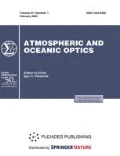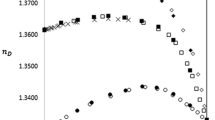Abstract
Binary mixtures of methanol, ethanol, isoamyl alcohol, and acetic acid with water in various ratios have been studied using Raman spectroscopy. Upon variations in organic solvent concentration, the intensities of stretching vibration bands of CH and OH group change within the spectral range 2600–3800 cm−1. For quantitative characterization of the partial concentrations of a solvent, we have chosen the integral intensity I CH of CH group stretching vibrations normalized to the total intensity of bands of CH and OH groups (I CH + I OH) within the 2600–3800 cm−1 range. With this normalization, the intensity I CH/(I CH + I OH) linearly depends on the volume fraction of the organic solvent throughout the whole range of its concentrations for the spectra of all mixtures. This allows noncontact measurements of concentrations of organic solvents in water solutions, including flammable or toxic ones. The relative concentration accuracy is 0.5, 1.1, and 1.5% for aqueous ethanol, methanol, and acetic acid, respectively.
Similar content being viewed by others
References
G. Bunte, W. Schweikert, J. Deimling, F. Schnurer, and H. Krause, “Detection of liquid explosives and/or flammable liquids by different techniques, detection of liquid explosives and flammable agents in connection with terrorism,” NATO Science for Peace and Security, Series B, Physics and Biophysics, 179–188 (2008).
M. Stancl and M. Kyncl, “Some detection procedures for liquid explosives, detection of liquid explosives and flammable agents in connection with terrorism,” NATO Science for Peace and Security, Series B, Physics and Biophysics, 79–96 (2008).
S. Wallin, A. Pettersson, H. Stmark, and A. Hobro, “Laser-based standoff detection of explosives: A critical review,” Anal. Bioanal. Chem. 395(2), 259–274 (2009).
M. N. Fiddler, I. Begashaw, M. A. Mickens, M. S. Collingwood, Z. Assefa, and S. Bililign, “Laser spectroscopy for atmospheric and environmental sensing,” Sens. 9(12), 10447–10512 (2009).
G. V. Sakovich, A. I. Chernov, S. V. Silant’ev, A. B. Vorozhtsov, A. A. Pavlenko, E. V. Maksimenko, M. M. Makogon, A. V. Klimkin, K. Yu. Osipov, Yu. N. Ponomarev, V. A. Kapitanov, and B. G. Ageev, “A prototype of an explosive detector on the basis of isotope CO2 laser,” Polzunovskii Vestnik, No. 4, 38–46 (2010).
R. C. Wiens, S. K. Sharma, J. Thompson, A. Misra, and P. G. Lucey, “Joint analyses by Laser Induced Breakdown Spectroscopy (LIBS) and Raman Spectroscopy at stand-off distances,” Spectrochim. Acta, A 61(10), 2324–2334 (2005).
J. L. Gottfried, F. C. De Lucia, C. A. Munson, and A. W. Miziolek, “Laser-induced breakdown spectroscopy for detection of explosives residues: A review of recent advances, challenges, and future prospects,” Anal. Bioanal. Chem. 395(2), 283–300 (2009).
M. E. Jacox, “Matrix isolation study of the infrared spectrum and structure of the CH3 free radical,” J. Mol. Spectrosc. 66(2), 272–287 (1977).
E. Rytter and D. M. Gruen, “Infrared spectra of matrix isolated and solid ethylene. Formation of ethylene dimmers,” Spectrochim. Acta, A 35(3), 199–207 (1979).
S. E. Boganov, S. V. Kudryashov, A. Yu. Ryabov, V. M. Klimkin, A. V. Klimkin, M. P. Egorov, and O. M. Nefedov, “Matrix IR spectroscopy study of methane and cyclohexane transformation in glow and spark discharges,” Izv. Tomskogo Politekhn. Universiteta 312(2), 143–148 (2008).
S. E. Boganov, S. V. Kudryashov, A. Yu. Ryabov, A. V. Klimkin, M. P. Egorov, and O. M. Nefedov, “The spectroscopic study of methane and cyclohexane transformation products in a glow discharge,” Atmos. Ocean. Opt. 21(8), 640–644 (2008).
M. L. Ramirez, W. Ortiz, L. C. Pacheco-Londono, and S. P. Hernandez-Rivera, “Remote detection of hazardous liquids concealed in glass and plastic containers,” IEEE J. Sens. 10(3), 693–698 (2010).
N. A. Marley, C. K. Mann, and T. J. Vickers, “Raman spectroscopy in trace analysis for phenols in water,” Appl. Spectrosc. 39(4), 628–633 (1985).
K. Tanabe and J. Hiraisha, “Vibrational frequencies and line-widths of C-H stretching Raman bands of organic molecules in aqueous solution,” Chem. Phys. Lett. 71(3), 460–462 (1980).
C. A. Holden, S. S. Hunnicutt, R. Sanchez-Ponce, J. M. Craig, and S. C. Rutan, “Study of complexation in methanol/water mixtures by infrared and Raman spectroscopy and multivariate curve resolution-alternating least squares analysis,” Appl. Spectrosc. 57(5), 483–490 (2003).
S. Dixit, W. C. K. Poon, and J. Crain, “Hydration of methanol in aqueous solutions: a Raman spectroscopic study,” J. Phys.: Condens. Matter. 12(21), L323–L328 (2000).
C. L. Sanford, B. A. Mantooth, and B. T. Jones, “Determination of ethanol in alcohol samples using a modular Raman spectrometer,” J. Chem. Educ. 78(9), 1221–1225 (2001).
D. Cleveland, M. Carlson, E. D. Hudspeth, L. E. Quat- trochi, K. L. Batchler, S. A. Balram, S. Hong, and R. G. Michel, “Raman spectroscopy for the undergraduate teaching laboratory: Quantification of ethanol concentration in consumer alcoholic beverages and qualitative identification of marine diesels using a miniature Raman spectrometer,” Spectrosc. Lett. 40(6) 903–924 (2007).
S. A. Burikov, T. A. Dolenko, S. V. Patsaeva, and V. I. Yuzhakov, “Diagnostics of aqueous ethanol solutions using Raman spectroscopy,” Opt. Atmosf. Okeana 22(11), 1082–1088 (2009).
S. Burikov, T. Dolenko, S. Patsaeva, Yu. Starokurov, and V. Yuzhakov, “Raman and IR spectroscopy research on hydrogen bonding in water-ethanol systems,” Mol. Phys. 108(18), 2427–2436 (2010).
S. A. Burikov, T. A. Dolenko, S. V. Patsaeva, and V. I. Yuzhakov, “Lazer analyzer of liquids with complex software,” Water: Chem. Ecol., No. 1, 31–37 (2010).
T. A. Dolenko, S. A. Burikov, S. V. Patsaeva, and V. I. Yuzhakov, “Manifestation of hydrogen bonds of aqueous ethanol solutions in the Raman scattering spectra,” Quantum Elektron. 41(3), 267–272 (2011).
S. A. Dolenko, S. A. Burikov, T. A. Dolenko, and I. G. Persiantsev, “Adaptive methods for solving inverse problems in laser Raman spectroscopy of multi-component solutions,” Pattern Recogn. Image Anal. 22(4), 551–558 (2012).
S. A. Burikov, S. A. Dolenko, T. A. Dolenko, and I. G. Persiantsev, “Application of artificial neural networks to solve problems of identification and determination of concentration of salts in multi-component water solutions by Raman spectra,” Opt. Mem. Neural Networks (Inform. Opt.) 19(2), 140–148 (2010).
S. Burikov, S. Dolenko, T. Dolenko, S. Patsaeva, and V. Yuzhakov, “Decomposition of water Raman stretching band with a combination of optimization methods,” Mol. Phys. 108(6), 739–747 (2010).
Author information
Authors and Affiliations
Corresponding author
Additional information
Original Russian Text © S.V. Patsaeva, T.A. Dolenko, S.A. Burikov, V.I. Yuzhakov, 2014, published in Optika Atmosfery i Okeana.
Rights and permissions
About this article
Cite this article
Patsaeva, S.V., Dolenko, T.A., Burikov, S.A. et al. Remote measurements of concentration of organic solvents in binary mixtures using Raman spectroscopy. Atmos Ocean Opt 27, 291–296 (2014). https://doi.org/10.1134/S1024856014040125
Received:
Published:
Issue Date:
DOI: https://doi.org/10.1134/S1024856014040125



